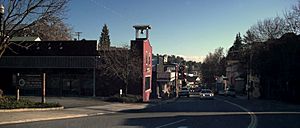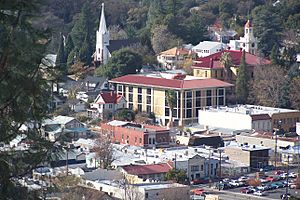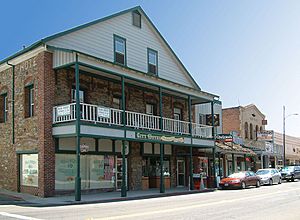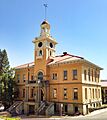Sonora, California facts for kids
Quick facts for kids
Sonora, California
|
|
|---|---|
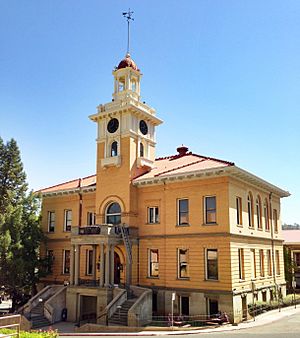
The county courthouse
|
|
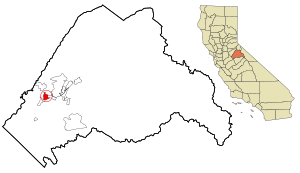
Location in Tuolumne County and the state of California
|
|
| Country | United States |
| State | California |
| County | Tuolumne |
| Incorporated | February 15, 1850 |
| Area | |
| • Total | 3.18 sq mi (8.23 km2) |
| • Land | 3.16 sq mi (8.19 km2) |
| • Water | 0.01 sq mi (0.04 km2) 0.45% |
| Elevation | 1,796 ft (547 m) |
| Population
(2020)
|
|
| • Total | 5,003 |
| • Density | 1,573.3/sq mi (607.9/km2) |
| Time zone | UTC−8 (Pacific) |
| • Summer (DST) | UTC−7 (PDT) |
| ZIP Codes |
95370, 95373
|
| Area code | 209 |
| FIPS code | 06-72674 |
| GNIS feature IDs | 1659815, 2411930 |
Sonora is a city in Tuolumne County, California. It's the main city and the county seat. Mexican miners from Sonora, Mexico, founded it during the California Gold Rush. That's how the city got its name! In 2020, about 5,000 people lived there. This was an increase from 4,610 people in 2010.
Contents
History of Sonora
Sonora was founded by Mexican miners during the California Gold Rush. It was a very busy place for mining and trade. At first, it was easy to find gold using simple methods. But soon, miners had to dig deeper for gold in quartz rocks. This was much harder and more expensive.
When gold became harder to find, its value went down. Businesses and miners realized it cost too much to get the gold. As the "gold fever" ended, Sonora's size and population slowly got smaller.
Today, a local museum helps people remember the Gold Rush. It shows what Sonora was like in those exciting times.
Geography and Location
Sonora is located at 37°59′04″N 120°22′54″W / 37.984361°N 120.381767°W. It's near where Highway 49 and Highway 108 meet. The city is about 1,825 feet (556 m) above sea level.
The United States Census Bureau says Sonora covers about 3.1 square miles (8.0 km2). Most of this area is land, with a very small part being water.
Climate and Weather
Sonora has cool, wet winters. Its summers are hot and mostly dry. In January, the average high temperature is 54.5 °F (12.5 °C). The average low is 33.5 °F (0.8 °C). In July, the average high is 94.6 °F (34.8 °C). The average low is 58.8 °F (14.9 °C).
The temperature reaches 90 °F (32 °C) or higher about 75 days a year. It drops to 32 °F (0 °C) or lower about 52 days a year. The hottest temperature ever recorded was 113 °F (45 °C) in June 1961 and July 1972. The coldest was 8 °F (−13 °C) in December 1972.
Sonora gets about 32.07 inches (815 mm) of rain each year. Most of the rain falls from November to April. Sometimes, there are summer thunderstorms that come from the Sierra Nevada mountains. The most rain in one month was 21.69 inches (551 mm) in December 1955.
Snowfall is rare, with an average of only 4.7 inches (0.12 m) per year. The most snow in one month was 30.5 inches (0.77 m) in January 1933. Sonora has a Mediterranean climate, which means it has hot, dry summers and mild, wet winters.
| Climate data for SONORA RS, CALIFORNIA (1903–2012) | |||||||||||||
|---|---|---|---|---|---|---|---|---|---|---|---|---|---|
| Month | Jan | Feb | Mar | Apr | May | Jun | Jul | Aug | Sep | Oct | Nov | Dec | Year |
| Record high °F (°C) | 75 (24) |
78 (26) |
84 (29) |
92 (33) |
103 (39) |
113 (45) |
113 (45) |
110 (43) |
108 (42) |
100 (38) |
89 (32) |
81 (27) |
113 (45) |
| Mean daily maximum °F (°C) | 54.5 (12.5) |
58.0 (14.4) |
62.4 (16.9) |
68.5 (20.3) |
77.1 (25.1) |
86.1 (30.1) |
94.5 (34.7) |
93.0 (33.9) |
86.7 (30.4) |
76.0 (24.4) |
63.5 (17.5) |
55.6 (13.1) |
73.0 (22.8) |
| Mean daily minimum °F (°C) | 33.4 (0.8) |
35.5 (1.9) |
38.0 (3.3) |
41.7 (5.4) |
46.7 (8.2) |
52.7 (11.5) |
58.7 (14.8) |
57.4 (14.1) |
52.7 (11.5) |
45.2 (7.3) |
38.1 (3.4) |
33.8 (1.0) |
44.5 (6.9) |
| Record low °F (°C) | 13 (−11) |
15 (−9) |
20 (−7) |
24 (−4) |
24 (−4) |
33 (1) |
39 (4) |
40 (4) |
33 (1) |
25 (−4) |
21 (−6) |
8 (−13) |
8 (−13) |
| Average precipitation inches (mm) | 6.13 (156) |
5.55 (141) |
5.10 (130) |
2.77 (70) |
1.27 (32) |
0.33 (8.4) |
0.04 (1.0) |
0.08 (2.0) |
0.39 (9.9) |
1.62 (41) |
3.46 (88) |
5.39 (137) |
32.14 (816) |
| Average snowfall inches (cm) | 2.3 (5.8) |
1.0 (2.5) |
0.5 (1.3) |
0.2 (0.51) |
0 (0) |
0 (0) |
0 (0) |
0 (0) |
0 (0) |
0 (0) |
0 (0) |
0.7 (1.8) |
4.7 (12) |
| Source: Weather Channel | |||||||||||||
Population and People
| Historical population | |||
|---|---|---|---|
| Census | Pop. | %± | |
| 1860 | 1,960 | — | |
| 1870 | 1,322 | −32.6% | |
| 1880 | 1,492 | 12.9% | |
| 1890 | 1,441 | −3.4% | |
| 1900 | 1,922 | 33.4% | |
| 1910 | 2,029 | 5.6% | |
| 1920 | 1,684 | −17.0% | |
| 1930 | 2,278 | 35.3% | |
| 1940 | 2,257 | −0.9% | |
| 1950 | 2,448 | 8.5% | |
| 1960 | 2,725 | 11.3% | |
| 1970 | 3,100 | 13.8% | |
| 1980 | 3,247 | 4.7% | |
| 1990 | 4,153 | 27.9% | |
| 2000 | 4,423 | 6.5% | |
| 2010 | 4,610 | 4.2% | |
| 2020 | 5,003 | 8.5% | |
| U.S. Decennial Census 1850–1870 1880-1890 1900 1910 1920 1930 1940 1950 1960 1970 1980 1990 2000 2010 |
|||
Population in 2010
In 2010, Sonora had a population of 4,903 people. This means there were about 1,593 people per square mile. Most of the people, about 90%, were White. Other groups included African American, Native American, and Asian people. About 11% of the population was Hispanic or Latino.
Most people lived in regular homes. A small number lived in group homes or institutions. There were 2,199 households in total. About a quarter of these homes had children under 18. The average household had about 2 people.
The median age in Sonora was 39.7 years old. This means half the people were younger than 39.7, and half were older.
Population in 2000
In 2000, Sonora had 4,423 people living in 2,051 households. The population density was about 1,456 people per square mile. The racial makeup was similar to 2010, with about 91% White people. About 8% of the population was Hispanic or Latino.
Many households, about 40%, had only one person living in them. About 15% of homes had someone living alone who was 65 or older. The average household size was about 2 people.
The median age was 41 years. This means half the people were younger than 41, and half were older.
Economy and Tourism
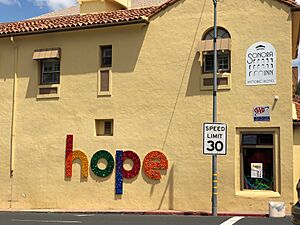
In the past, Sonora's economy was based on mining and cutting down trees. Today, it mostly relies on tourism. One of the two lumber mills in Tuolumne County closed in 2009 but reopened in 2011.
Sonora is close to Yosemite National Park. This means many visitors to Yosemite stop in Sonora. The city also benefits from being near Railtown 1897 State Historic Park and Columbia State Park. These parks offer fun historical experiences for visitors.
Education Opportunities
Sonora has several schools for students. These include Sonora Union High School and Sonora Elementary School. There is also Dario Cassina High and the Foothill Horizons Outdoor School.
For higher education, Columbia Community College is in Tuolumne County. It offers two-year degrees. If students want to go to a four-year university, they can travel about 50 miles. Options include University of California, Merced or California State University, Stanislaus in Turlock.
Culture and Arts Scene
The local newspaper for Sonora is called The Union Democrat.
Sonora is a popular place for filming movies and TV shows. The Tuolumne County Film Commission says over 300 films and TV series have been made here.
You can visit local museums to learn about the Gold Rush. They show what historic Sonora was like.
The city is also home to Sierra Repertory Theatre. This professional theater company puts on many musicals and plays. They perform at two different theaters: the East Sonora Theatre and the Fallon House Theatre in Columbia.
Sonora also has the Tuolumne County Arts Alliance. This group supports local artists and cultural events.
The pilot episode and other scenes for the TV show Little House on the Prairie were filmed in Sonora.
Notable People from Sonora
- Vaughn Armstrong – an actor
- Melvin Belli – a lawyer
- David Carkeet - a writer
- Jack Cassinetto – a painter
- Phil Coke – an MLB pitcher
- Molly Culver - an actress
- Charles Dellschau – an artist
- T.J. Dillashaw - a UFC Bantamweight Champion
- Ross Dwelley - an NFL tight end
- Larry Franco - a film producer
- James P. Hogan – a writer
- Jenny O'Hara – an actress
- Josh Parry - an NFL fullback
- Dan Pastorini – an NFL quarterback
- Francis "Rocco" Prestia - a bassist for Tower of Power
- Tata Vega - an entertainer
- Kahale Warring - an NFL Tight End
Images for kids
See also
 In Spanish: Sonora (California) para niños
In Spanish: Sonora (California) para niños



